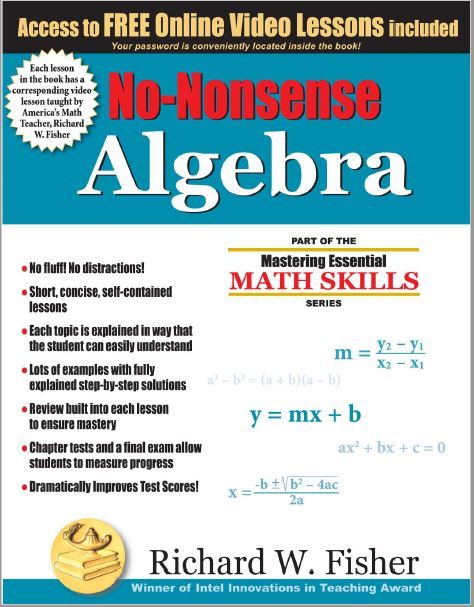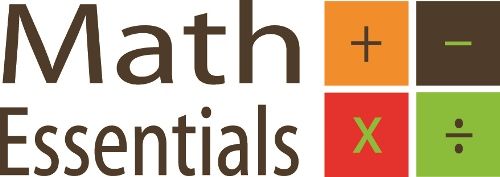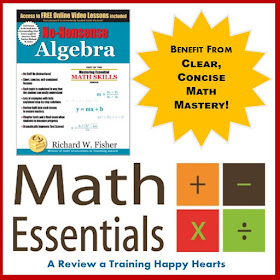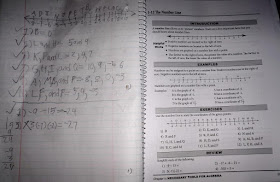My oldest son likes to learn math independently in short stints of 15-20 minutes, preferably online. I like to check in on his learning, preferably offscreen. Thus, when I saw No-Nonsense Algebra from Math Essentials, I thought, Perfect! (Or almost perfect.) The online portion of the program could appeal to my son and an offline paper portion appeals to me. (He might not be 100% ready for full-on Algebra, but he definitely could stretch with pre-Algebra, and may even roll right into the rest without problems. So it was that I opted to review this high-school level Math course with my just-entering middle school son.
What Makes the Program Helpful?
No-Nonsense Algebra consists of a 275-page softcover book and a corresponding series of video lessons taught by Richard W. Fisher (which can be accessed using a code in the book.)
Each lesson is:
- concise (so math lessons need not drag on on any given day)
- self-contained (so students who struggle with particular concepts can bone up on those specific topics without having to do every lesson in the book)
- inclusive of helpful hints, clear examples, exercises for practice, and exercises for review (so mastery happens)
- explained both in writing and through video lessons (which helps reach students with different learning styles, or, in the case of my family, helps reach paper-loving Mom and screen-loving son)
Chapter Reviews and a Final Review are also included in the book, as are helpful extras, which include:
- solutions for all problems (so student can self-check their work)
- a glossary (which is handy for students who have not internalized "math speak")
- a list of important formulas (which helps Moms like me who have not done Algebra in ages, and, of course, helps students, too)
- a list of important symbols (which is, again, handy for those who confuse or have forgotten math-related symbols)
- tables for multiplication, commonly used prime number, squares and square roots, and fraction/decimal equivalents (which are super handy for children who struggle to recall facts and figures)
Truly, I am impressed with how complete and concise No-Nonsense Algebra is. The program lives up to its name by offering a way for students to achieve math mastery without having to wade through fluff and distractions - and without Mom or Dad having to do much 1:1 teaching.
How Did We Use It?
Of course, when using No-Nonsense Algebra with students below high school level, sitting down 1:1 can be helpful, so that is what my son and I did when we first cracked open No-Nonsense Algebra. Or rather, we sat down 3:1, for, when I sat down with my oldest to complete Lesson 1-1 together, my two younger children decided to join us. They were curious about the video lesson. So, I capitalized on the moment, had all three children grab paper, and completed that first No-Nonsense Algebra lesson together.
To my surprise, even my seven year old met with success when adding integers during Lesson 1-1. Honestly, I did not think he would be able to do it, but, he was interested, and, as the lesson progressed, he quickly caught on to the rules of how to add positive and negative numbers, So did my 10-year-old daughter. Lessons are that clear!
Thus, the following day, out of curiosity, I suggested that we all sit down together again to study Algebra. As we completed Lesson 1-2 on Subtracting Integers, my seven year old lost interest, which I was completely okay with, for this program is a high school program and my 7-year-old is just a typical child - not a math savant.
I thought my daughter might also lose interest in joining her big brother and me for Algebra lessons, but, surprisingly, she did not. Instead, she persisted and happily completed Lesson 1-2 alongside her big brother, even asking me to grade her. Since we don't typically do grades here, and, since she has been doing math at a much lower grade level than her big brother, I was both amused and impressed by her desire to work through No-Nonsense Algebra lessons.
Oh, how my daughter beamed knowing she'd just learned some math alongside her big brother- and had done well at it, too! It was such an awesome moment. My daughter had been suffering from lack of confidence in her skills, and the fact that she liked the No-Nonsense Algebra lesson format and succeeded with it thrilled me!
Going with this success, I kept our family's approach to No-Nonsense Algebra the same for the next two lessons: Mom and the kids on the couch with a laptop, the book, some notebooks, and a few pencils. However, as we got into multiplying and dividing integers, something became obvious: whereas my oldest son could handle the work, holes in my daughter's mastery of multiplication and division facts prevented her from continuing her streak of Algebra success.
My daughter clearly understood concepts presented in the lessons, but struggled with quick and correct math fact recall and, thus, did not do all of her figuring right. Thus, before she could get down about her progress with No-Nonsense Algebra, I gave her a big hug and said, "Wow! You have been doing HIGH SCHOOL math and you GET IT! The only reason you've had some trouble here is because the paths in your brain that help you quickly recall facts are not 100% yet. When you get those down, you are going to be a whiz at this!"
At this, my daughter smiled, got thoughtful, and asked if we could go back to work on her facts and, then, return to Algebra. "Why, absolutely!" was my response, and, so, the next day, she was back to math fact drills and practice while my oldest continued with No-Nonsense Algebra.
At this point, I asked my oldest if he was ready to try doing his No-Nonsense Algebra on his own, which he was. So, I explained that he could even check his answers on his own after he completed either all the odds or all the evens on any given page, and, then, if he had succeeded with the problems he attempted, he could be done for the day.
Since then, 3-5 days a week, my son has used No-Nonsense Algebra as he main math curriculum. At first, he did well with this - succeeding with lessons and seldom complaining. However, when work got harder, the complaints began: "This is too hard." "I don't like this." "No, I don't need your help. I can figure this out, but it's stupid."
"No, it's not son. It's challenging, but useful and well explained. I am happy to help you if you need me to do so. Daddy is, too. Then, if you still don't get it, we can pause for a while," was, more or less, my response.
As is typical for my son, he did not want the help nor did he want to push through the tough spots. For, my son does not like when he does not "get" math concepts right away, nor does he like it when he cannot easily solve problems in his head. He likes copying problems out of a book onto notebook paper even less. Still - I am happy to say - he pushed through all these "don't likes", persisted with learning, and made it to Lesson 1-12 by Monday of this week, which impressed me (and proved to both him and me that he can succeed with higher level math when he puts his mind to it and has a quality resource to help him!)

When I asked my son about his experience with No-Nonsense Algebra thus far, he said:
"No-Nonsense Algebra is an algebra program that teaches using online videos and a workbook. In each video, a teacher explains what the video is about (a math point) and asks you to write along with what he is saying. He takes you through examples. Then, the workbook has more problems that you have to do alone. It has the answers in the back so you can check your work.
I think there are too many problems on most pages, so Mom has me do half of them - which I still think is crazy. If I get most of them right, I can keep going with the next lesson. If I don't, I have to do more problems.
The lessons are set up to do a ton at one time - the short videos and all the problems, but my mom said, when we are busy, I can just do 15 minutes of work at a time. That usually means the video and some of the problems. When we are not busy, I do a video and all of one half of the problems.
I really don't like this (doing 1/2 the problems in a lesson), because it takes up time, is frustrating, I get things wrong, and I have to do more problems.
The man teaches well. I will give him that, but the workbook is hard and my mom does not let me write in it. I don't like copying problems and doing the work out.
I think I might like it later, but right now, it is above my grade level. I want to do some more 6th grade math and, then, may try this again."
So, as you can see, my son is progressing, does not like to practice math with a lot of exercises, and has come to a point where we need to pause our work on No-Nonsense Algebra, not because the program is not a good one - for it is excellent - but because my son could benefit from a bit more lower math before progressing further. (This is not surprising since he is only 11 years old and has, to date, used a hodge podge of math resources in a sometimes super relaxed way.)
With this in mind, I believe that once my oldest completes a bit more "on grade level" math, he will be in a prime spot to excel with the rest of No-Nonsense Algebra. I think my daughter will, too. In fact, she asked if she could add a quick comment to this review, and, said:
I did the first few lessons of No-Nonsense Algebra, but then it got a little too hard.
I discovered Algebra is fun, but I need to learn more of my other skills before I can continue. I want to go back to this book when I finish my other skills.
Did you hear that? My 10 year old said written Algebra is fun! She wants to learn more using this resource. And she will!
So, even if my daughter is on pause with the program, and I am giving her big brother a break from it, too, I am keeping our No-Nonsense Algebra book at the front of our math cubby as incentive for my daughter to get through the work of solidifying her basic math facts, so she can get back to applying algebra concepts using No-Nonsense Algebra. I am also considering getting her the 4th and 5th grade or middle school books that Math Essentials offers, since it appears that the format of the lessons - with video explanations and examples, and uncluttered pages of written examples, exercises, and review - work well for her.
Likewise, I will encourage my oldest to return to No-Nonsense Algebra as soon as he is ready to do so.
I would say Math Essentials would work well for other children who prefer concise, straight-forward, math learning or review, too! I am truly pleased to have been introduced to No-Nonsense Algebra for my own homeschool purposes as well as to have this resource now to recommend to high school students that I mentor who are preparing for college entrance exams or just struggling with high school math. No-Nonsense Algebra, I believe, can help students reach math mastery fairly quickly and painlessly, not to mention inexpensively. (Where some math curricula cost big bucks, this full algebra program currently costs just $28.95)
Learn More

Get social with Math Essentials on Facebook at https://www.facebook.com/math.essentials/

See what 60 Homeschool Review Crew families thought about
No-Nonsense Algebra.





No comments:
Post a Comment
Thank you so much for taking time to comment. We LOVE comments, read every one and appreciate all your thoughts, tips, questions and ideas.